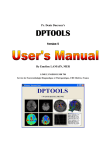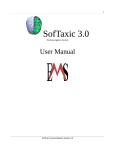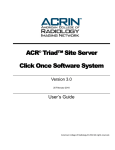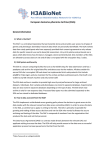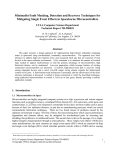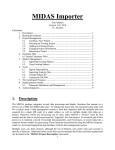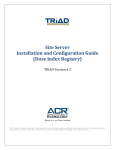Download PAIN User Manual
Transcript
USER MANUAL January 4, 2014 Version 1.0 PAIN Repository User Manual Version 1.0 December, 2013 1 Contents 1 - General Information ........................................................................................................... 3 2 - Contact Us ........................................................................................................................ 3 3 – User Registration and Login Information ........................................................................... 4 Login to the Pain Repository – Returning Users ........................................................................... 4 4- Checklist – How to Become a PAIN Repository Member .................................................... 5 5 - Required Documents ......................................................................................................... 6 6 - Subject Confidentiality ....................................................................................................... 6 7 - PAIN Standardized Data Repository.................................................................................. 7 Site Qualification................................................................................................................................. 7 Subject Metadata ............................................................................................................................... 8 Data Acquisition .................................................................................................................................. 8 8 - PAIN Archived Data Repository......................................................................................... 8 9 – Quality Control .................................................................................................................. 9 10 - Downloading Data ........................................................................................................... 9 Future Open Access Data Policy ..................................................................................................... 9 11 - FAQ................................................................................................................................10 11 - Workflow ........................................................................................................................11 2 PAIN Repository User Manual Version 1.0 December, 2013 1 1 - General Information The Pain and Interoception Imaging Network (PAIN) seeks to characterize brain signatures associated with chronic pain disorders, understand underlying mechanisms, and identify novel treatment targets. PAIN provides the infrastructure for storage of standardized resting state functional and structural brain imaging data and associated biological, physiological and behavioral metadata from multiple scanning sites, and provides tools to facilitate analysis of the resulting comprehensive data sets. PAIN also incorporates a repository of archived, non-standardized data for both healthy controls and pain patients from already completed studies. Any investigator interested in contributing structural, DTI and resting state data and a small set of clinical metadata acquired in a standardized way, can join PAIN and gain access to the PAIN Standardized Repository. In addition, members can deposit any existing pain-related data sets that they are willing to share with other members for analyses in the PAIN Archived Repository. Contributors will be asked to provide an accompanying minimal data set including diagnosis, age and sex of subjects. PAIN data are stored in a scalable, secure, fault-tolerant, high availability location at the Oppenheimer Center for Neurobiology of Stress at the University of California, Los Angeles. In the future, as the repository grows, subgroups of members may develop their own pain disorder specific set of metadata that they feel will increase the opportunities for disease specific analyses. Such future metadata may include disease specific questionnaires, or genetic, biological or physiological samples, including GWAS data, gut microbiome related data or other omics data. 2 - Contact Us For questions regarding the PAIN Repository please contact [email protected]. 3 PAIN Repository User Manual Version 1.0 December, 2013 3 – User Registration and Login Information User Registration – New Users Access to the PAIN Repository requires a non-transferable user account and password. Click here to complete the user registration form and obtain an account. You will need to provide a valid email address, organization affiliation, academic status, and indicate the primary use of data and choice of membership to the PAIN Standardized Repository, the PAIN Archived Repository or both. The PAIN staff will contact you with further instructions. After completing the user registration process, approved investigators are assigned a username and password. For additional requirements to become a Pain Repository member click here. Login to the Pain Repository – Returning Users Click here to login to the Pain Standardized Repository restricted section, or here to login to the PAIN Archived Repository. You will need a username and password to view datasets, upload or download data. 4 PAIN Repository User Manual Version 1.0 December, 2013 4- Checklist – How to Become a PAIN Repository Member Checklist: 1) Complete the user application and indicate your preference to contribute to the Standardized Repository, the Archived Repository or both. 2) Complete and sign the Membership Agreement for the repository you wish to join. 3) Obtain a user account. 4) Agree to the Data Sharing Policy and submit and Data Use Agreement. 5) For each dataset you will contribute, please provide: i. A copy of the IRB approval page or equivalent authorization for human subject research from your institution. ii. Consent form. 6) To contribute data to the Standardized Repository: a. Complete the site qualification routine. b. Remove all potential subject identifiers from the imaging data and metadata. c. Transfer imaging data and clinical metadata to the PAIN Repository using the SFTP Interface for Standardized Data. d. Provide a list of subjects IDS and acquisition dates in .txt format, to be included with each data transmission. e. Provide the standard clinical metadata for each subject. f. Contribute data from at least 20 subjects per year. To contribute data to the Archived Open Repository: a. Remove all potential subject identifiers from the imaging data and metadata. b. Transfer data to the PAIN Repository using the SFTP Interface for Archived Data. c. Provide a list of subjects IDs and acquisition dates in .txt format, to be included with each data transmission. d. Provide the original scanning protocol(s) for the data and/or methods. 5 PAIN Repository User Manual Version 1.0 December, 2013 1 5 - Required Documents Contributing members to the PAIN Repository requires the following documents: A signed Membership Agreement A copy of the most recent IRB approval page for your study or equivalent document authorizing your biomedical research involving human subjects issued by your institution. The study consent form. A signed Data Sharing Agreement between your site and the PAIN Repository. 1 6 - Subject Confidentiality To protect subject confidentiality, data must be de-identified prior to their transfer to the PAIN repository. All identifiers listed below or other elements which could potentially be used to identify study participants must be removed from images and assessments: 1. 2. 3. 4. 5. 6. 7. 8. 9. 10. 11. 12. 13. 14. 15. 16. 17. Names Street addresses Phone numbers Fax numbers Email addresses Social Security numbers Medical record numbers Health Plan beneficiary numbers Account numbers Certificate/license numbers Vehicle identifiers and serial numbers, including license plate numbers Device identifiers and serial numbers Web Universal Resource Locators (URLs) Internet protocol (IP) address numbers Biometric identifiers including finger and voice prints Full face photographic images and any comparable images Other unique identifiers Imaging de-identification tools can be found at: 1) Cornell Anonymization Toolkit http://sourceforge.net/projects/anony-toolkit/ 2) LONI Debablet: http://www.loni.usc.edu/Software/DiD Please note that several other subject de-identification tools currently exist. The list above is provided for your convenience only, and The PAIN Repository staff neither endorses nor guarantees the products listed. If you require assistance with subject de-identification, please contact the PAIN Repository staff at [email protected]. 6 PAIN Repository User Manual Version 1.0 December, 2013 7 - PAIN Standardized Data Repository To allow combined multisite analysis, imaging data contained in the PAIN Standardized Repository are acquired using validated protocols for both patient and control subjects, and are accompanied by a common clinical metadata set. Members interested in contributing data to the Standardized PAIN Data Repository and accessing other datasets are required to follow the steps outlined below: 1) 2) 3) 4) 5) 6) 7) Agree to the Membership Agreement Obtain a user account and password Agree to the Data Sharing Agreement Complete the site qualification routine Acquire data following the PAIN protocol Provide the standardized subject metadata Upload data from at least 20 subjects per year Site Qualification To address the need for imaging standardization across multiple sites, investigators interested in contributing data to the Standardized Data repository are expected to complete the site qualification routine, which involves the acquisition of a series of human volunteer scans (and optional phantom scans) for each modality they will be providing data. The same scanner used during the site qualification phase must be used for acquiring standardized data that will become part of the PAIN repository. Future upgrades in scanner hardware or software may require a new site qualification to ensure compatibility with other standardized datasets. For additional information on site qualification, imaging acquisition and study protocols please consult the MRI Procedures Manual. 7 PAIN Repository User Manual Version 1.0 December, 2013 Subject Metadata The standard clinical metadata accompanying the neuroimaging data includes demographics, diagnosis, pain severity, comorbidity and cognitive and affective measures. PAIN staff will assist investigators to integrate the prescribed procedures into their studies to ensure that collected data will fit into the PAIN Repository database schema. A description for the recommended clinical, demographical and psychosocial assessments and variables for the PAIN Standardized Repository can be found at http://pain.med.ucla.edu/standardized/meta-data/meta-data-dictionary/ For your convenience, demographics and general subject information can be submitted online at http://pain.med.ucla.edu/standardized/contribute-data/ Data Acquisition All PAIN Standardized imaging data must be uploaded in DICOM format. For scanning protocols and additional acquisition information, please consult the MRI Procedures Manual. 8 - PAIN Archived Data Repository The PAIN Archived Data Repository is an open data resource available to all interested researchers. Members can deposit existing pain data sets which they are willing to share with other contributors, and in turn have access to other archived datasets. To facilitate multisite collaborations, investigators are encouraged to provide subjects' sex, age, primary pain problem, and the original acquisition parameters for the archived data they wish to upload to the Archived Data Repository. Ideally, contributing investigators may also provide relevant publication(s) based on the respective data set. Members interested in contributing data to the Archived PAIN Data Repository and accessing other datasets should follow the steps outlined below: 1) 2) 3) 4) 5) Agree to the Membership Agreement Obtain a user account and password Provide basic subject demographics Provide scanning protocols and/or methods, if available Upload data 8 PAIN Repository User Manual Version 1.0 December, 2013 9 – Quality Control The quality of images in the PAIN Repositories is a critical component for the feasibility of future analyses. The PAIN Standardized Repository therefore has developed a robust QC pipeline based on the LONI pipeline, including qualitative visual inspection and quantitative metrics to assess each scan. The process consists of standardized, validated methods using software including Analysis of Functional Images (AFNI [NIH]), fMRI QC (fBIRN [Duke BIAC]), DICOM browser (WUSTL), Diffusion Toolkit and Freesurfer (Harvard/MGH), FMRIB Software Library (FSL [Oxford]), LONI Pipeline, and Statistical Parametric Mapping (SPM). The PAIN Repository will provide prompt feedback to member sites for their first few Standardized Data uploads regarding compatibility and suggested corrections, if needed. The repository also maintains a PAIN blog for members on the site that is used for more general communication regarding scans, changes to the repository, governance, etc. All PAIN Standardized data will undergo comprehensive quality control prior to be made available in the repository. PAIN Archived Repository data will undergo automated quality control prior to being made available. 10 - Downloading Data During its initial 3 years, PAIN Repository data will only be available to members who have contributed data. Investigators who choose to contribute solely archived data, will only have access to the PAIN Archived Repository. Any investigator who contributes PAIN Standardized data will have access to all data included in the PAIN Repository. Membership Access to all Standardized Data Standardized Data Repository √ Access to all Archived Data scans √ √ Archived Data Repository Future Open Access Data Policy Although initially PAIN Repository data will be reserved for contributing members it is planned that the repository will be opened for wider access to all pain investigators after 3 years. Full access to qualified users will include acceptance of a Data Use Agreement and the submission of an online application form (including the investigator’s institutional affiliation and the proposed research to be conducted using PAIN data). Applications for PAIN data are reviewed by the PAIN Data Sharing and Publications Committee (PDSPC) to ensure investigator affiliation with a scientific or educational institution and on the basis of the proposed research. Incomplete applications or those without a clear research focus will not receive approval. 9 PAIN Repository User Manual Version 1.0 December, 2013 11 - FAQ Why participate in an imaging repository for chronic pain? Chronic pain continues to be one of our most significant and difficult health problems. Brain imaging has become a primary tool for discovery of mechanisms and treatments for pain but it is very clear that further advances will require large datasets from well characterized participants. It is almost impossible for individual laboratories or even small consortia to generate large enough datasets for Big Data approaches. Participation in the PAIN Repository will enable access to large and well characterized samples of patients with various forms of chronic pain and healthy controls needed for large-scale analyses. How does PAIN differ from other data sharing efforts? The PAIN repository is specifically targeted towards using multimodal neuroimaging for discovery of mechanisms and biomarkers related to chronic pain and chronic pain treatment. The PAIN repository is multivariate. It contains three types of MRI scanning data for each subject, high quality structural information, DTI, and resting state function imaging. Unlike site specific task related data, these three imaging modalities are obtainable with almost any high resolution scanner and are relatively context independent. In addition to the three scan modalities the structured PAIN repository includes a standardized set of clinical metadata to characterize pain severity, location, quality and impact as well as affective and cognitive variables to facilitate subgroup and classification analyses. Capability for inclusion of biological variables is built into PAIN. How does PAIN differ from other imaging repository initiatives? Although there is utility in gathering and making available neuroimaging data collected from studies with very diverse procedures, scanning parameters, and limited or unstandardized clinical data; this type of ‘open’ repository has significant limitations. Much more valuable is scanning data collected according to standardized and validated protocols that can be reliably combined in multi-site large scale analyses and accompanied with consistent clinical and eventually biological information. The PAIN repository therefore includes two imaging databases. The Structured PAIN repository is the primary PAIN repository. It contains patient and healthy control scans that have been collected using validated protocols to allow for combined multisite analysis. It also contains a standardized set of clinical metadata for each subject that covers demographics, diagnoses, pain severity, comorbidity, cognitive and affective measures. Scans are assessed for compatibility with the repository standards and each scan has a quality control record for use in analysis. The PAIN Open Archive is an open repository in which contributors can deposit any structural, DTI or resting state scans of pain patients or healthy controls which do not conform to the guidelines for scans in the supervised repository. Scans in the archive have minimal clinical information and can be very diverse in terms of scanning procedures. The OA is seen as a resource to deposit and access data from already completed studies, older datasets or those with minimal subject data available. How is confidentially maintained? The PAIN repository only contains coded* data, meaning all descriptive information that would link a set of data with the identity of a subject, has been destroyed. This includes removal of facial structures from high-resolution structural MRI data. Some biological information that is stored along with scanning data (such as genetic data) may in rare cases have the potential for subject identification and this needs to be reflected in the IRB approval for that data. The PAIN repository has a general UCLA IRB approval for maintaining the database. All uploaded datasets have approval from their local IRB for collection and for de-identified sharing such as the transfer to the repository. Most IRB's do not consider data sharing itself to fall under the definition of "human subjects research", but interested users should request such a determination from their IRB before sharing data. The PAIN staff can assist in the de-identification of the data if needed. 10 PAIN Repository User Manual Version 1.0 December, 2013 *Data are separated from personal identifiers through the use of a code. The code key will be held by the Collaborator only. The PAIN Repository will never retain this linking file. PAIN data do not contain any personal identifiers. How are data shared? Any investigator who is willing to contribute structural, DTI and/or resting state data for subjects with a chronic pain condition along with minimal demographic information is eligible to join PAIN and participate in the Open Archive repository. Investigators who can collect and contribute data conforming to the protocols for the Standardized Repository will have access to the full standardized multisite data. Who operates the PAIN repository? The Oppenheimer Center for Neurobiology of Stress in the Dept. of Medicine at UCLA (Director: Emeran A. Mayer) is the initial developer of the PAIN repository and is responsible for maintaining the hardware, website, data transfer protocols, backup systems, reporting, administration and organization of the repository, with input from the members via an Executive Committees. The PAIN repository has start-up funding from the National Institute of Health (NIDA, NCCAM) and governance of the repository is accomplished via the Executive Committee with a rotating membership drawn from PAIN Repository members. The Executive Committee determines publication and access policy, minimal scan contributions for full membership and a fair priority access system when needed based on number and type of scans submitted. How do I participate? If you are interested in more information about becoming part of the PAIN Repository please send an email inquiry to: [email protected]. 11 - Workflow 11












